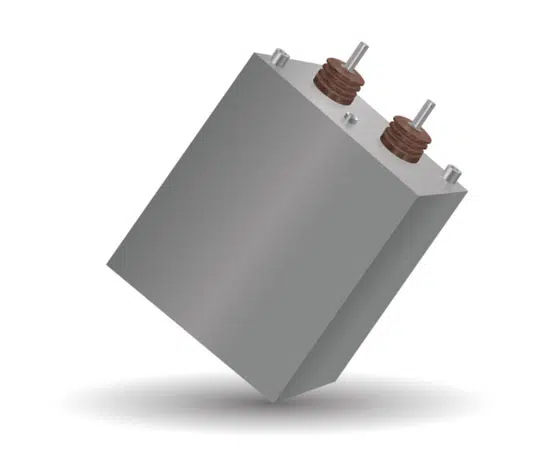KYOCERA AVX Celebrates the release of its 1,000th TRAFIM series high-voltage power film capacitor for DC filtering applications.
Since launching the series in 1990, KYOCERA AVX has manufactured more than 365,000 of the now-1,000 unique TRAFIM Series part numbers, all of which are widely renowned for their controlled self-healing technology, high energy density, and safe, high-reliability, and long-lifetime performance across a wide range of industrial, military, research, traction, and renewable energy applications.
KYOCERA AVX, a leading global manufacturer of advanced electronic components engineered to accelerate technological innovation and build a better future, is celebrating the release of its 1,000th TRAFIM Series high-voltage power film capacitor for DC filtering applications up to 6,000VDC.
TRAFIM Series capacitors are widely renowned for their high energy density and controlled self-healing technology, which ensures proven-safe, high-reliability performance over 100,000-hour lifetimes at rated voltage and 80°C hot spot temperature — and up to 240,000 hours with appropriate derating — in a wide range of high-voltage industrial, military, research, traction, power transmission, and renewable energy applications. Since introducing the first TRAFIM Series capacitors to market in 1990, KYOCERA AVX has produced more than 365,000 of the now-1,000 unique TRAFIM Series part numbers, representing more than 20,000 tons of capacitors deployed in various global industries with zero catastrophic failures.
TRAFIM Series capacitors were initially developed in 1987 for use in the traction industry, but the series has since undergone continuous design and performance improvements that have significantly expanded its utility and application. For example, the integration of FIM technology, which features high-temperature polypropylene film coated with metallized aluminum and impregnated with vegetable oil, enables the series’ benign failure mode, which exclusively consists of capacitance losses, effectively prevents potential explosions resulting from avalanche effect, and ensures proven-safe and reliable high-energy-density performance over extended product lifetimes up to 240,000 hours.
Additional improvements include the release of a new case size that is 66% smaller than the initial offering while maintaining the same extended lifetime expectancy and impressive failure rate of <100FIT, as well as increasing the maximum specific energy to 495J/L at operating temperatures up to 95°C. Over time, the series has also been qualified to the IEC 61071, IEC 61881, IEC 61373, IEC 60068-2, and EN-45545 standards. Due to these and other significant design and performance improvements over the last several decades, TRAFIM Series capacitors are now ideal for use in an expansive range of global, cross-market DC filtering applications, including DC links, power converters, drives, traction systems, windmills, substations, energy storage, and pulse discharge, resonant filtering, and active correction devices.
“KYOCERA AVX is thrilled to celebrate this latest manufacturing milestone and is extremely proud of having developed 1,000 unique TRAFIM Series high-voltage power film capacitors proven to deliver safe, effective, reliable, and long-lifetime performance with zero catastrophic failures in DC filtering applications that, after more than 30 years in production, now extend across multiple global market segments,” said Claude Vincent, Engineering Power Manager, R&D at KYOCERA AVX. “As is the case with many specialized KYOCERA AVX components, the significant expansion of the TRAFIM Series has been catalyzed by custom design requests, which help us better anticipate and efficiently satisfy the evolving needs of DC filtering applications in various industries. In fact, custom designs have inspired more than 95% of the TRAFIM capacitors we produce.”
TRAFIM Series capacitors feature large, rectangular, hermetically sealed, unpainted, and nonmagnetic stainless steel cases with volumes up to 46L and are currently available as 1,000 unique part numbers — including the newest model, TRAFIMA00, released in September 2021 — with 12 standard voltage ratings spanning 1,950VDC to 6,000VDC, capacitance values extending from 110µF to 10,600µF ±10% tolerance (standard), or ±5% or ±2% on request), and operating temperatures spanning -55°C to +95°C. The series also delivers high specific energy, up to 495J/L, and long-lifetime performance extending up to 100,000 hours at rated voltage and 80°C hot spot temperature with a 2% end-of-life capacitance reduction (∆C/C) and up to 240,000 hours with appropriate derating. Its two standard case sizes measure 340mm x 117mm and 340mm x 165mm (L x W), are available with heights spanning 215mm to 815mm, and feature an integrated grounding nut. They are also available with two or four M8 or M17 female or M12 or M30 male terminals and with optional mounting brackets.
Lead-time for standard TRAFIM Series capacitors is currently 30 weeks, and information about custom TRAFIM Series sizes and shapes and application specific designs is available upon request.
































